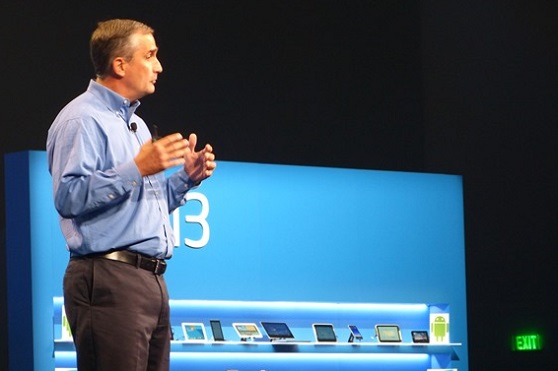Intel chief executive Brian Krzanich showed off a laptop running on a 14-nanometer Intel system-on-a-chip processor today. During his keynote at the Intel Developer Forum, Krzanich also predicted that there will be tablets with Intel chips in them that will ell for less than $100 this holiday season.
IDF is a coming-out event for Intel’s new top brass: Krzanich as the top new boss and president Renee James. Of course, their talk is going to be a bit overshadowed by Apple’s own press conference.
Krzanich and James are promoting Intel’s newest chips for mobile devices and addressing how Intel will break into the business in a bigger way as more of the market transitions from PCs to newer devices such as tablets and smartphones. One of the new chips is code-named Quark, Intel’s tiniest chip yet. Intel’s targeting the “Internet of things” and wearable computing with it.
The transition to mobile remains Intel’s biggest challenge and its greatest opportunity, as competitors who use ARM-based technology dominate that space.
Intel appointed Krzanich and James to the top spots after former CEO Paul Otellini announced he would retire early.
At IDF, Krzanich talked about Intel’s focus on making 4G LTE wireless chips, a product that will bring Intel into competition with Qualcomm. Intel is now shipping a major chip in that market.
Krzanich said Intel plans to leave no market segment untapped. “Innovation and industry transformation are happening more rapidly than ever before, which play to Intel’s strengths. We have the manufacturing technology leadership and architectural tools in place to push further into lower power regimes. We plan to shape and lead in all areas of computing.”
Much of IDF will focus on Bay Trail, the codename for a 22-nanometer system-on-chip processor that will have much lower power consumption and considerable processing power for tablets and 2-in-1 hybrid laptops, which consumers can use as either laptops or tablets. As the mainstay of Intel’s product offering this fall, Bay Trail will be used in upcoming 2-in-1s, tablets, and other small form factor devices — but not so much in smartphones. Bay Trail will also see use in both Windows devices and Android machines. The Android push will show up in tablets appearing next year.
Bay Trail is one of the main offsprings of Intel’s Silvermont chip architecture. Other technologies based on Silvermont are Avoton, a new server chip, and Merrifield, aimed at phones. Intel hopes to put the ARM camp back on the defensive as it launches the Silvermont-based processors across all of its markets.
You can also expect to hear more later about Intel’s interest in wearable computing, such as those inspired by Nike’s Fuelband fitness accessories and Google Glass. Intel will also give an update on perceptual computing, though it won’t have huge news around that subject. Intel’s rumored set-top box will not likely make a splash at the event.
Meanwhile, Genevieve Bell, the director of the interaction and experience research at Intel Labs, will speak Thursday about the future of mobile technology. She will fill the shoes of Justin Rattner, Intel’s chief technology officer, who is on a leave of absence. Her talk, “Seven billion futures, and you’re one of them,” will focus on the future, beyond three to five years out. Intel’s mobility chief, Herman Eul, will also talk Wednesday about Intel’s mobile strategy in particular.
In her presentation, James envisioned a new era in which every device and every object computes, meaning that integrated computing solutions must be smaller, faster, more versatile and produced in higher volume.
“Semiconductor-based technology will continue to address the world’s most pressing problems and exciting opportunities, changing how we live our lives, run our cities and care for our health,” said James. “Intel has played a pivotal role in every previous technology transition and will continue to enable breakthroughs in the future.”
“Smartphones and tablets are not the end-state,” Krzanich said. The next wave of computing is still being defined. Wearable computers and sophisticated sensors and robotics are only some of the initial applications.”
The 14-nanometer chip is codenamed Broadwell and it will be launched for mobile devices and PCs in 2014. Intel will also offer a next-generation Atom chip, based on a code-named Airmont chip architecture, next year. That chip will be five times smaller than today’s Atom chips and have 10 times lower power.
“The Quark [chip] is interesting, but what’s most interesting is what it means to business model,” said Patrick Moorhead, an analyst at Moor Insights & Strategy. “Intel can now effectively pop IP blocks in and out of an SOC with much less resources and expense. Taken to the extreme, they could license it to others and they can add their own IP. If successful, what does that mean to ARM?”
Regarding the cheap tablets, Moorhead said, “Low price tablets with a good experience could upset the current dynamics, but I think it would need to be at 14nm to make any headway versus the ARM-based incumbents.”
VentureBeat's mission is to be a digital town square for technical decision-makers to gain knowledge about transformative enterprise technology and transact. Learn More

